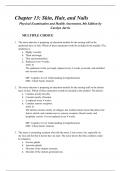Chapter 13: Skin, Hair, and Nails
Physical Examination and Health Assessment, 8th Edition by
Carolyn Jarvis
MULTIPLE CHOICE
1. The nurse educator is preparing an education module for the nursing staff on the
epidermal layer of skin. Which of these statements would be included in the module? The
epidermis is:
a. Highly vascular.
b. Thick and tough.
c. Thin and nonstratified.
d. Replaced every 4 weeks.
ANS: D
The epidermis is thin yet tough, replaced every 4 weeks, avascular, and stratified
into several zones.
DIF: Cognitive Level: Understanding (Comprehension)
MSC: Client Needs: General
2. The nurse educator is preparing an education module for the nursing staff on the dermis
layer of skin. Which of these statements would be included in the module? The dermis:
a. Contains mostly fat cells.
b. Consists mostly of keratin.
c. Is replaced every 4 weeks.
d. Contains sensory receptors.
ANS: D
The dermis consists mostly of collagen, has resilient elastic tissue that allows the
skin to stretch, and contains nerves, sensory receptors, blood vessels, and
lymphatic vessels. It is not replaced every 4 weeks.
DIF: Cognitive Level: Understanding (Comprehension)
MSC: Client Needs: General
3. The nurse is examining a patient who tells the nurse, I sure sweat a lot, especially on
my face and feet but it doesnt have an odor. The nurse knows that this condition could
be related to:
a. Eccrine glands.
b. Apocrine glands.
c. Disorder of the stratum corneum.
d. Disorder of the stratum germinativum.
, ANS: A
The eccrine glands are coiled tubules that directly open onto the skin surface and
produce a dilute saline solution called sweat. Apocrine glands are primarily
located in the axillae, anogenital area, nipples, and naval area and mix with
bacterial flora to produce the characteristic musky body odor. The patients
statement is not related to disorders of the stratum corneum or the
stratumgerminativum.
DIF: Cognitive Level: Applying (Application)
MSC: Client Needs: Physiologic Integrity: Physiologic Adaptation
4. A newborn infant is in the clinic for a well-baby checkup. The nurse observes the infant
for the possibility of fluid loss because of which of these factors?
a. Subcutaneous fat deposits are high in the newborn.
b. Sebaceous glands are overproductive in the newborn.
c. The newborns skin is more permeable than that of the adult.
d. The amount of vernix caseosa dramatically rises in the newborn.
ANS: C
The newborns skin is thin, smooth, and elastic and is relatively more permeable
than that of the adult; consequently, the infant is at greater risk for fluid loss. The
subcutaneous layer in the infant is inefficient, not thick, and the sebaceous glands
are present but decrease in size and production. Vernix caseosa is not produced
after birth.
DIF: Cognitive Level: Applying (Application)
MSC: Client Needs: Health Promotion and Maintenance
5. The nurse is bathing an 80-year-old man and notices that his skin is wrinkled, thin, lax,
and dry. This finding would be related to which factor in the older adult?
a. Increased vascularity of the skin
b. Increased numbers of sweat and sebaceous glands
c. An increase in elastin and a decrease in subcutaneous fat
d. An increased loss of elastin and a decrease in subcutaneous fat
ANS: D
An accumulation of factors place the aging person at risk for skin disease and
breakdown: the thinning of the skin, a decrease in vascularity and nutrients, the
loss of protective cushioning of the subcutaneous layer, a lifetime of
environmental trauma to skin, the social changes of aging, a increasingly
sedentary lifestyle, and the chance of immobility.
DIF: Cognitive Level: Applying (Application)
MSC: Client Needs: Health Promotion and Maintenance
, 6. During the aging process, the hair can look gray or white and begin to feel thin and
fine. The nurse knows that this occurs because of a decrease in the number of
functioning:
a. Metrocytes.
b. Fungacytes.
c. Phagocytes.
d. Melanocytes.
ANS: D
In the aging hair matrix, the number of functioning melanocytes decreases; as a
result, the hair looks gray or white and feels thin and fine. The other options are
not correct.
DIF: Cognitive Level: Understanding (Comprehension)
MSC: Client Needs: Health Promotion and Maintenance
7. During an examination, the nurse finds that a patient has excessive dryness of the skin.
The best term to describe this condition is:
a. Xerosis.
b. Pruritus.
c. Alopecia.
d. Seborrhea.
ANS: A
Xerosis is the term used to describe skin that is excessively dry. Pruritus refers to
itching, alopecia refers to hai loss, and seborrhea refers to oily skin.
DIF: Cognitive Level: Remembering (Knowledge)
MSC: Client Needs: Health Promotion and Maintenance
8. A 22-year-old woman comes to the clinic because of severe sunburn and states, I was
out in the sun for just couple of minutes. The nurse begins a medication review with
her, paying special attention to which medication class?
a. Nonsteroidal antiinflammatory drugs for pain
b. Tetracyclines for acne
c. Proton pump inhibitors for heartburn
d. Thyroid replacement hormone for hypothyroidism
ANS: B
Drugs that may increase sunlight sensitivity and give a burn response include
sulfonamides, thiazide diuretics, oral hypoglycemic agents, and tetracycline.
DIF: Cognitive Level: Applying (Application)
MSC: Client Needs: Health Promotion and Maintenance





